Jeremie Averous's Blog, page 15
April 6, 2021
How Dense Cities Get Rewarded in the Collaborative Age
In the book ‘Hedge‘ Nicolas Colin makes the point that dense cities are rewarded in the Collaborative Age. “The Entrepreneurial Age seems to reward large cities and nothing else , and old jobs have been radically displaced as a result . As factories are now empty , the occupied working class is now employed primarily in services — services that are more and more concentrated in cities. Hence , as Richard Florida puts it, the city has become the “ new factory floor”“

There are conflicting movements at stake here: increased possibilities for remote work (enhanced by the Covid crisis), making it possible to live in the countryside at the condition of having a strong and reliable internet connection; and the network effect of cities that allow the deployment of more effective logistics and services. It seems however for Nicolas Colin that metropolis have a future, in particular because “workers are being redeployed from the suburban industrial class of the twentieth century to the urban service class of the twenty – first century“, and because networked services are orders of magnitude more efficient there.
There could possibly even be an argument on the fact that the creative class would tend to move to the countryside or small towns whereas the working class would tend to concentrate in cities, creating further inequality (and being an opposite trend than the one observed in the 20th century).
In any case, dense cities and metropolis seem to have a future as places of creativity, encounters, and network efficiency. How much concentration on a limited number of cities will happen remains to be seen.
On the same topics, previous posts include
‘How the Collaborative Age Seems to Create Increasing Rural Abandonment‘‘How Cities May Remain Stable Social Structures Through the Collaborative Age‘‘Will cities remain in the Collaborative Age?‘The post How Dense Cities Get Rewarded in the Collaborative Age first appeared on The Fourth Revolution Blog.
April 3, 2021
How Instability of Income and Occupation is not New
In the interesting book ‘Hedge‘ by Nicolas Colin, the issue of career in the new Collaborative Age (which he calls ‘Entrepreneurial Age’) is addressed. “The mark of the Entrepreneurial Age is greater instability at every level . It leads to permanent fluctuations in households ’ sources of income . Today’s workers alternate overlapping periods of training , wage – earning , starting a business , looking for a job , working as a freelancer.”
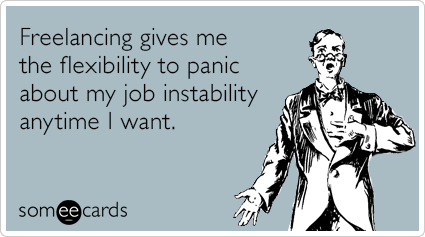
This obviously seems a significant departure from the Industrial Age stable wage-earning model that would require substantial changes in the setup of our social security nets, and in our psychology.
But is that really such a big change compared to the current situation? I observe a lot of my friends that went into more conventional careers being now retrenched or otherwise deemed redundant and who actually feel a bit lost because they were not prepared to this instability. The fact that people are made redundant when they reach 45+, in particular in management roles, is not new, but it is often underestimated or not talked about. However it has always existed due to the pyramidal organisation of the corporation. It has just maybe been accelerated in the later years due to more frequent restructuring, mergers and acquisitions. Thus, although it accelerates, this instability is not new. It is just that we are not psychologically prepared for it by society.
I find from my experience that it is actually all in the psychology. I have started my own consulting company at 40, instead of continuing a conventional career in the management of established companies. It has taken me some years to get used to the ups and downs, adjusting my personal system to have sufficient reserves in case of crisis, and it is now not a problem any more (even with Covid-19!).
Thus, be prepared for instability of income and occupation. But that is not new, and it is just that we need to be more prepared for it psychologically than what is usually recognized.
The post How Instability of Income and Occupation is not New first appeared on The Fourth Revolution Blog.
April 1, 2021
How to Overcome Both Science Reproducibility and Innovation Crisis
Stuart Buck’s post ‘Escaping science’s paradox‘ addresses the current science reproducibility crisis, and in particular if the current context of replication issues and suspicions could diminish innovation. His view is that “I do not think there’s a contradiction between reproducibility and innovation. Contrary to common belief, we can improve both at once“.

The paper first gives a raft of useful references about the issues of reproducibility and the apparent decrease of innovation (compared to the budgets spent) in science today. One particular issue is the capability of institutions to fund ‘out of the box’ innovative research.
The author proposes to achieve a consistent high rate of innovation “by incentivizing failed results, and by funding “Red Teams” that would aim to refute existing dogma or would be entirely outside it.” He first proposes to make sure there is less bias towards positive results in publications by enticing publication of null result experiments or even negative results experiments. And then he proposes to make sure there is always an independent challenge to avoid groupthink, and that systematic replication of important results should be funded.
It is quite interesting to observe how improving the outcome of scientific research ends up being a psychological balance exercise, making sure to erase biases towards positive results and providing means to foster innovation. This demonstrates how the shaping of the institutional framework is important to achieve the results we need for scientific research.
On the same topic – read our previous post ‘How to Overcome the Science Reproducibility Crisis‘
The post How to Overcome Both Science Reproducibility and Innovation Crisis first appeared on The Fourth Revolution Blog.
March 30, 2021
How Media Advertising Got Upended by Internet
In this excellent summary paper ‘Did Google and Facebook kill the media revenue model?‘ Frederic Filloux takes a deep insight on the evolution of media advertising evolution in last decades. It benefitted initially paper media and it got completely upended by Internet. The interesting part is that its actual value has also plummeted – making it cheaper for people to advertise but also diminishing the possible revenue stream for media.
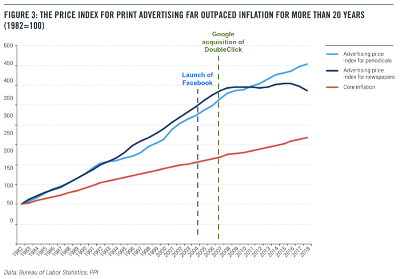
“The inefficiency of advertising in print, radio, and TV has always been its historical flaw.” By providing a far more targeted solution, internet advertising suddenly increased dramatically advertising efficiency. In addition, it was suddenly possible to much better measure the effectiveness of a campaign to improve it.
In addition, availability of advertising channels created a major deflation of advertising expenditure and the post contains staggering graphs (out of which the illustration of the post is extracted) showing how total advertising value plummeted in the last decade, with total media adverting expenditure diminishing by more than 25% in most developed countries (after an historical increase that was much more than inflation, so it is also sort of a correction).
Could printed media have reacted earlier? Maybe, but as Frederic Filloux concludes, the changes were so systemic and overwhelming that some exceptions may have transformed sufficiently, but certainly not the entire industry. “Most of the legacy media were in denial. They acted too late and too little. But they were not in a position to do otherwise.”
At the end, media advertising is another area where internet has upended the value chain, and at the same provided more value to advertisers. It should be seen as a quite positive shift for the overall value chain and consumers, were it not for the overwhelming position of Google and Facebook.
The post How Media Advertising Got Upended by Internet first appeared on The Fourth Revolution Blog.
March 27, 2021
How Social Media Could Be Adjusted to Make a Positive Contribution
Quite opposed to our previous post ‘How Social Media Currently Rewards Bad Behavior‘, Seth Godin post ‘Amplify possibility‘ provides a much more positive view on the adjustments that would be required to make social media more positive.

His analysis of the current situation echoes the analysis of many: “The social media companies optimized their algorithms for profit. And profit, they figured, would come from engagement. And engagement, they figured, would come from confounding our instincts and rewarding outrage.”
He uses a metaphor that I find powerful. Many people slow down to watch when there is an accident on the road, but we are almost in social media today at the stage where we create accidents to engage and get the attention of people!
However, according to him, “That’s not how the world actually works” Actual influencers, he argues, behave differently. It is more a long term engagement, a commitment over time, the development of deep relationships and expertise.
Thus it should not be too difficult to tweak the engagement rules of social media to reward those behaviors instead of the ones we see. “Amplify possibility. Dial down the spread of disinformation, trolling and division. Make it almost impossible to get famous at the expense of civilization. Embrace the fact that breaking news doesn’t have to be the rhythm of our days. Reward thoughtfulness and consistency and responsibility.”
I find this approach enticing, although obviously that would require quite a focus change from the major social medias of today, and less seeking of profit and market share. Maybe that could be an idea for a social network competitor?
The post How Social Media Could Be Adjusted to Make a Positive Contribution first appeared on The Fourth Revolution Blog.
March 25, 2021
How Social Media Currently Rewards Bad Behavior
This article explains the position of Ellen Pao (ex CEO of Reddit and now quite opposed to Silicon Valley giants for a number or reasons including accusations of gender discrimination) ‘Social Media Reward Bad Behavior’ or another similar interview in Inc.com ‘Why the Trolls Are Winning the Internet‘. Her point is that she observes that social media today rewards bad behaviors because it is not managed in the interest of the people, and because possibly the teams managing the current tools are not sufficiently diverse.

“It makes me really sad, because the internet is such a powerful tool, and it introduced this idea that you could connect with anyone. And it’s been turned into this weapon used to hurt and harass people.” She is quite strong in her words about the impact of social media on the users today.
One of the reasons she mentions is that “One of the big problems is that these platforms were built by homogeneous teams, who didn’t experience the harassment themselves, and who don’t have friends who were harassed. Some of them still don’t understand what other people are experiencing and why change is so important.”
An important point is that she does not believe that this problem can be addressed at the scale of the current social networks. “I don’t think it’s possible anymore except at very small scale, because the nature of interactions at scale has become very attention-focused: “The angrier and meaner I am online, the more attention I get.” This has created a high-energy, high-emotion, conflict-oriented set of interactions. And there’s no clear delineation around what’s a good or a bad engagement. People just want engagement.“
All in all, her view is quite negative on the possibility for social media to change quickly because of its interest to engage people to spend more time on their platform. Still she provides an interesting path for improvement, which is to make sure there is an increased diversity in the social media teams.
Refer also to our previous post ‘How Facebook Model is Addiction and Growth – and Why It Can’t Change‘
The post How Social Media Currently Rewards Bad Behavior first appeared on The Fourth Revolution Blog.
March 23, 2021
How to Look at Life From a Different Perspective
I like this quote from Muhammad Ali: “Looking at life from a different perspective makes you realize that it’s not the deer that is crossing the road, rather it’s the road that is crossing the forest.”
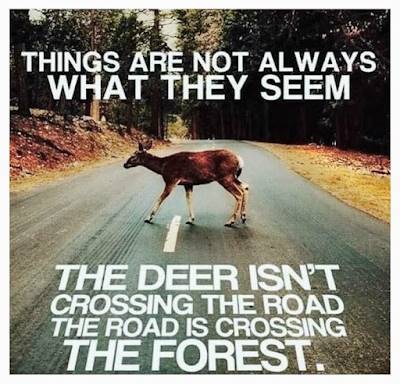
I find it is quite a striking example of how to look at things differently, or at least how much distance we need to take to be able to look at things differently.
I find that taking a systemic view of complex situations is extremely helpful. This is an extremely important way to reach the root cause of issues.
One further step, once we have a good systemic view, is to try to go one dimension up so that we take a really all-encompassing view of the situation. This is where we can attain such viewpoints like the one of Muhammad Ali about the deer crossing the road.
Exercising about changing viewpoint and going up in terms of observation level is quite an important skill to better understand our world. Are you practicing?
The post How to Look at Life From a Different Perspective first appeared on The Fourth Revolution Blog.
March 20, 2021
How Social Network Legal Protection for Content Should be Reviewed
Since their inception, all social networks have been protected under US Law by a disposition called Section 230. Quartz’s update Section 230 provides quite a comprehensive coverage of the issue. Basically, social networks operate under a status of content distributors, not publishers thus not taking any responsibility in the content itself – thus preventing any lawsuit based on content. While this contributed immensely to their development, as they have grown we can observe that this cannot apply any longer, and social networks have had to take measures by themselves to monitor and regulate their content.

There are many voices now to reconsider whether this section should continue to apply to the major internet content providers. Section 230 states that “No provider or user of an interactive computer service shall be treated as the publisher or speaker of any information provided by another information content provider.” In reality, social networks are not just distributing, they also produce some content, and decide routinely which content to put first and visible, which in itself is a gesture almost akin to producing a meta-content. Because of their ubiquity, they need to regulate the content they show. De facto, the amount of content regulation they enforce nowadays proves they can’t be satisfied to be just distributors, they are inching closer to being publishers, that have to have an eye on the content they broadcast.
It won’t be easy to change it: “Curiously, some Big Tech companies have come around to support efforts to weaken Section 230. Facebook and Google, for example, were early supporters of the bill that eventually became FOSTA and Facebook CEO Mark Zuckerberg has called for more reform. These small concessions could head off more onerous regulation down the road. But the more cynical read is that the biggest Big Tech companies would gain an advantage over smaller competitors who lack the resources to navigate the legal morass that would follow the repeal of Section 230.“
It will be quite interesting to watch this change unfold in the next few months, and what impact this will have on social network content and governance. At least the legislator understands large social networks cannot be considered as neutral distributors, and some liability will be enforced on the content in the near future.
The post How Social Network Legal Protection for Content Should be Reviewed first appeared on The Fourth Revolution Blog.
March 18, 2021
How the Right Start-Up Ideas Are About Making What People Want
In this interesting post ‘Billionaires Build‘, Paul Graham of Y Combinator explains what should be the most important criterion for selecting promising start-ups: producing what people want. And, Paul Graham adds, as it means also selecting future billionaires, it should also be the criterion for that selection.
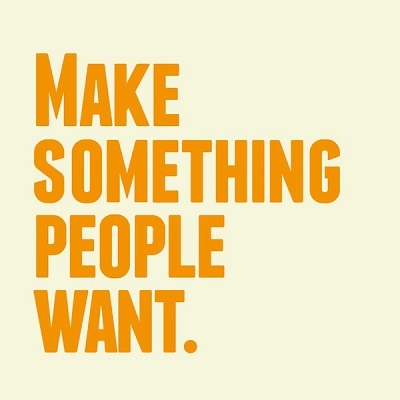
His point is that exploiting people is not a sustainable proposition. Proposing something that people want is. And this needs to be demonstrable: “The crucial feature of the initial market is that it exist. That may seem like an obvious point, but the lack of it is the biggest flaw in most startup ideas. There have to be some people who want what you’re building right now, and want it so urgently that they’re willing to use it, bugs and all, even though you’re a small company they’ve never heard of. There don’t have to be many, but there have to be some.”
In addition, Paul Graham mentions it is important to be interested into what is getting built (which avoids getting out too early), and have a thorough understanding of future users (even better if you are using your proper service first).
Based on my experience what is really important is to have demonstrated that people are ready to pay for the service even if it is just a Proof of Concept with limited capabilities. That it solves someone’s problem by making life easier. If only all start-up founders could take this as a principle!
The post How the Right Start-Up Ideas Are About Making What People Want first appeared on The Fourth Revolution Blog.
March 16, 2021
How the Value of an Early Start-Up is Only the Team
When assessing a start-up project at the end, beyond the idea and business growth expectations, what is really important is the quality of the team. And that is what should be assessed first.
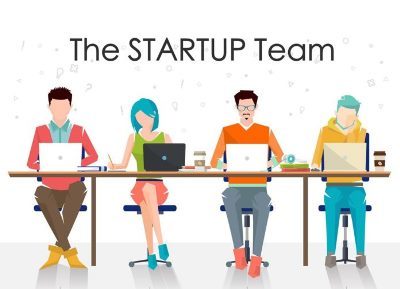
The ‘team’ means first, more than one person. Many investors shun investing in a single founder venture (there can be exceptions when there are several committed early investors, some of which plan to join the start-up). But in any case there needs to be a small core team with diversified experience and profiles (one commercial, one technical, one funding for example) and it is even much better if there are experienced mentors involved in some sort of advising committee (senior people from the industry, successful founders of start-ups etc).
Then one needs to assess the business-savviness, the resilience and motivation of the team members; and how they will all work together. This is bit harder and requires as a minimum to interview the team before committing to anything like an investment.
The team is what will successfully address the unexpected obstacles on the way ahead of the start-up, and that’s what need to be assessed first, before any look at a highly uncertain business plan.
This is a short series of posts where I want to share some thoughts from my experience as a Business Angel with now about 15 investments over the last 5 years, and review of 100s of start-up pitches per year. Previous posts include ‘How Early Start-Up Valuation is too Often too High‘ and ‘How Start-Up Founders Too Often Define Themselves by How Much Money They Raised‘
The post How the Value of an Early Start-Up is Only the Team first appeared on The Fourth Revolution Blog.



